
|
The Sentry™
Card# MTU-017

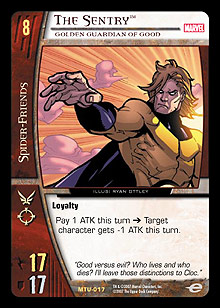
While his stats aren’t much bigger than those of the average 7-drop, Sentry’s “Pay ATK” power can drastically hinder an opponent’s attacking options in the late game.
Click here for more
|
|
|

|
|
|

 |
 |
|
|
| |
|
For the first article I’ve chosen to drag kicking and screaming back into the limelight, I thought it would be nice to go all the way back to the beginning. That is, back to the beginning of my writing career on Metagame.com and the two-part article on the development of Deep Green that I submitted in the wake of my teammate Ian Vincent’s Pro Circuit win in San Francisco. The memory of that weekend—tracking Ian’s progress all the way through to the Top 8—will stay with me for a long time despite the game’s most infamous act of regicide on Day 1. Nearly as enjoyable was watching the deck develop after it had left the closed ranks of the team; it put two players in the Top 8 of $10K Hamilton, and two more met in the finals of $10K Charlotte with each player’s version showcasing its own tweaks and tricks. It’s probably the article I’ve written that means the most to me personally, and it’s great to get the chance to give it the spotlight one more time.

April 19, 2005. That’s when he sauntered into view with his natty black trench coat and Wolverine, Logan–sized frame. Ahmed Samsarra, White King—one of the only 3-drops in the history of Vs. System to rival Dr. Light, Master of Holograms for raw power (particularly now that the good Doctor has received some long overdue “surgery” from UDE’s own Zatanna to keep his powers under control).
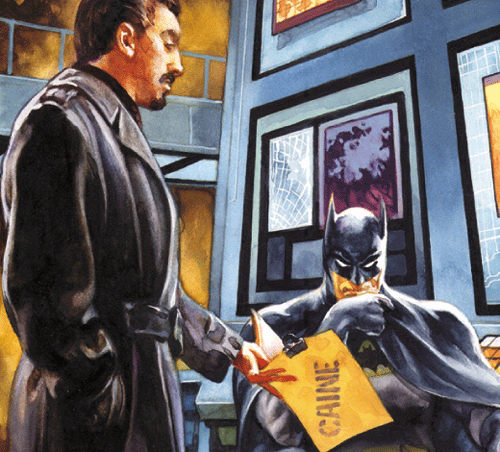
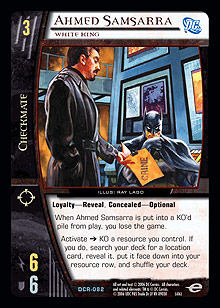 Of course, that raw power only means something in a context, but the Pro Circuit debut of the Silver Age format was a context that happily allowed him to flourish. It was the first step toward a major tournament format that took in a wide range of sets (and the diversity of teams that brings with it) but excluded the dominating Origins strategies and silver bullets that stomped around Golden Age tournaments like gorillas in the mist. No Dr. Doom, Diabolic Genius with all his brutal board control plot twists. No Roy Harper, Arsenal and his convoluted build phase machinegun rampages. No High Voltage throwing the fastest and most aggressive cards from every set in the game full in the face of off-balance opponents. This was a new, untested format with a dizzying array of possible strategies. Every Modern Age deck from past formats could be built; many Golden Age strategies could be tweaked, re-jigged, or simply ported over card-for-card into the new Age; and Infinite Crisis brought a lot of new material. Of course, that raw power only means something in a context, but the Pro Circuit debut of the Silver Age format was a context that happily allowed him to flourish. It was the first step toward a major tournament format that took in a wide range of sets (and the diversity of teams that brings with it) but excluded the dominating Origins strategies and silver bullets that stomped around Golden Age tournaments like gorillas in the mist. No Dr. Doom, Diabolic Genius with all his brutal board control plot twists. No Roy Harper, Arsenal and his convoluted build phase machinegun rampages. No High Voltage throwing the fastest and most aggressive cards from every set in the game full in the face of off-balance opponents. This was a new, untested format with a dizzying array of possible strategies. Every Modern Age deck from past formats could be built; many Golden Age strategies could be tweaked, re-jigged, or simply ported over card-for-card into the new Age; and Infinite Crisis brought a lot of new material.
Dr. Light was the obvious benefactor of all this turmoil. A massively popular card in every format in which he’s been legal, his appeal is obvious. Even ignoring his potential in pure combo decks, if he stays alive for one recovery step, his 1 resource point investment (pay 3, then get an immediate free 2-drop) suddenly turns into a net profit of 1, 3, 5 resource points. So anything that wanted to compete with Dr. Light was going to have its work cut out for it. On the other side of the coin, there was Squadron Supreme, flying the flag for aggro munchkins everywhere with their lopsided stats and “look ma, no hands!” approach to life. Trying to compete with both the rush of Squadron and its relations and the tricky, fiddly plots that seem to follow Dr. Light around is quite a tightrope walk.
Enter the King.
First things first: staring you in the face are the raw stats. A 6 ATK / 6 DEF 3-drop with both range and concealed—optional is immense. Loyalty—reveal prevents him from being a trivial card to splash but doesn’t present any problems when working within his team. Then you hit the drawback. If he’s put into a KO’d pile from play, you lose the game. Okay, I think to myself, the ability better be pretty juicy to justify a drawback like that. And boy, was I not disappointed. Searching your deck for a location and putting it directly into the resource row for only the cost of an exhaust is an immensely powerful ability. The toolbox that Ahmed gives you access to stretches from team-ups to character tutors and takes in a satisfying range of combat tricks, utility cards, and focused hate. The trivial cost and repeatable nature of this tutoring simply make him all the more attractive.
Once you’ve recognized the double-edged power of a card like Ahmed, there are two questions to consider:
1) How can his drawback best be minimized? What is the most space-efficient way of doing it, what is the most reliable way of doing it, and what is the way of doing it that’s hardest to disrupt? Do you need multiple layers of protection, and if so, what do you need to do to fit them all together?
2) What deck and strategy can make the most use of his ability? What other cards give you the biggest payoff for being able to fetch locations at will?
The first question immediately threw up a few possibilities. Threat Neutralized was obvious but not a particularly powerful card in its own right, and also not searchable without running something like Scandal, Savage Spawn or Power and Wealth. Huntress, Reluctant Queen seemed like a likely inclusion; not only does it protect Ahmed from Quick Kill, No Mercy, and No Man Escapes the Manhunters, but it also protects all your characters from other disruption like X-Treme Maneuver and Magnetic Force (and even from ongoing removal like Mutant Massacre). But this didn’t feel like enough. So, for now I left the question of how to protect Ahmed on hold—I wanted to know what the payoff was going to be and if working on the payoff would point toward another solution to his unique drawback.
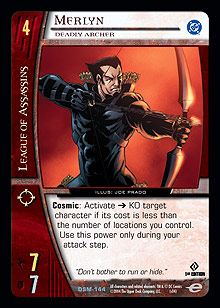 So, on to the second question. What to do with all those locations? I should probably point out that I’ve had a League of Assassins / Brotherhood deck in Golden Age since the release of Superman, Man of Steel (although it has been gathering a little dust in recent months), and as such, I’m familiar with the power of Merlyn, Deadly Archer. And the thought of running the White King with Merlyn had my eyes out on stalks. At a brainstorming session with Ian Vincent the day after the Sneak Preview tournament, I threw together a rough draft of what would turn into Deep Green, starting with four copies each of Ahmed and Merlyn. A check of the older available League of Assassins characters didn’t turn up that many (as one might expect of an Origins team), but Sensei, Martial Arts Master’s interaction with Merlyn was too good to pass up. We largely discounted the Batman starter deck characters; a copy of Hook, Hired Killer was the only serious consideration. Bronze Tiger, Benjamin Turner is a good man and also made the shortlist. So, on to the second question. What to do with all those locations? I should probably point out that I’ve had a League of Assassins / Brotherhood deck in Golden Age since the release of Superman, Man of Steel (although it has been gathering a little dust in recent months), and as such, I’m familiar with the power of Merlyn, Deadly Archer. And the thought of running the White King with Merlyn had my eyes out on stalks. At a brainstorming session with Ian Vincent the day after the Sneak Preview tournament, I threw together a rough draft of what would turn into Deep Green, starting with four copies each of Ahmed and Merlyn. A check of the older available League of Assassins characters didn’t turn up that many (as one might expect of an Origins team), but Sensei, Martial Arts Master’s interaction with Merlyn was too good to pass up. We largely discounted the Batman starter deck characters; a copy of Hook, Hired Killer was the only serious consideration. Bronze Tiger, Benjamin Turner is a good man and also made the shortlist.
As for Checkmate characters, working up from 1-drops, Jacob Lee, Knight piqued my interest for having concealed and an alternate recruit cost that works a treat with a card I’d already marked out for use with Merlyn—Rook Control. The ability to drop Jacob into play for free on turn 4, switching him across with Merlyn, was an attractive one. Connie Webb, Knight was interesting but seemed unlikely to be necessary if we were running sufficient characters and appropriate tutors.
Looking at 2-drops, our options started to widen, and we started thinking about what we were likely to be playing against. We thought it likely that Squadron Supreme would be one of the most popular decks at the PC, and Ian pointed out that to be most comfortable against Squadron, we wanted two things to happen on turn 2: we wanted a 3 ATK 2-drop with which to stun Shape, Malleable Mutant or Melissa Gold ◊ Songbird, Sonic Carapace, and we wanted a Mikado and Mosha, Angels of Destruction in hand to stun Joystick, Janice Yanizesh or Ape X, Xina. As such, Bronze Tiger, Benjamin Turner just wasn’t going to cut it. Thankfully, Infinite Crisis gave us the perfect answer (in more ways than we realized) in the form of Talia, Beloved Betrayer. A 3 ATK / 3 DEF body, a useful vengeance ability, and not one but two useful affiliations? (And, for those of us who care about such things, fantastic art, to boot.) Where do I sign? We also decided that at least a single copy of Sarge Steel, Knight was essential, giving us a Checkmate 2-drop to fetch with Brother I Satellite if we miss Talia.
Moving up the curve, we toyed with a number of options for extra 3- and 4-drops. We wanted a few things: a non-King Checkmate 3-drop to fetch with Brother I Satellite if it wasn’t safe to make Ahmed; a Checkmate 4-drop to fetch in case we weren’t teamed-up with anything else; and some kind of plan to handle opposing Ahmeds, Dr. Lights, and other problem characters.
The backup 3-drop was, for a while, Christopher Smith ◊ Peacemaker, Obsessed Outlaw. We chose him for his ability to get stuns through to inconveniently hidden or protected Dr. Lights or an opposing Ahmed. He combined with a copy of Fatality, Flawless Victory at 4 to give us an alternate route for dealing with inconvenient smaller characters. But the more we tested, the more we found that the Christopher Smith into Fatality plan never quite seemed to gel, and Graziella Reza, Knight ended up coming in as a bigger character that could soak up some damage against the more aggressive decks.
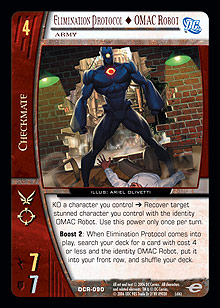 After some consideration, we finally settled on Elimination Protocol ◊ OMAC Robot, Army as our Checkmate 4-drop. While his stats are underwhelming, he’s visible (the 4-drops with backup abilities and concealed seemed likely to concede too much damage) and not a King. Harry Stein, King in Check seemed like a terrible idea, as we could get into serious trouble playing him after Ahmed and we couldn’t make use of his ability. Elimination Protocol also allows us to build up our hand size by discarding him to Brother I Satellite, Slaughter Swamp, or Enemy of My Enemy and then picking him back up with Brother Eye on turns where we don’t control the initiative. After some consideration, we finally settled on Elimination Protocol ◊ OMAC Robot, Army as our Checkmate 4-drop. While his stats are underwhelming, he’s visible (the 4-drops with backup abilities and concealed seemed likely to concede too much damage) and not a King. Harry Stein, King in Check seemed like a terrible idea, as we could get into serious trouble playing him after Ahmed and we couldn’t make use of his ability. Elimination Protocol also allows us to build up our hand size by discarding him to Brother I Satellite, Slaughter Swamp, or Enemy of My Enemy and then picking him back up with Brother Eye on turns where we don’t control the initiative.
At 5, we had a few options. The first inclusion was Maxwell Lord, Black King. An immense body combined with a powerful payment power capable of doing everything from preventing reinforcement and team attacks to directly negating combat tricks made him a shoe-in. A non-King Checkmate character was, this time, easy to locate and much more attractive than Elimination Protocol—Annihilation Protocol ◊ OMAC Robot, Army is a character we were happy to make space for and that provided more fuel for Brother Eye. Talia, Daughter of Madness provides another Villains United drop with an ability that we could potentially make excellent use of with Sarge Steel in our deck, deploying him in the middle of combat via a Slaughter Swamp or search card discard to take the bullet for our 4- or 5-drop.
Turning to 6-drops, the first inclusion was, as suggested earlier, Sensei, Martial Arts Master. His synergy with Merlyn in a deck that is more capable than most of keeping Merlyn cosmically charged is undeniable, and it provides a devastating kick against any deck that plans to curve up. (G’Lock, for example, has issues with Sinestro, Green Lantern of Korugar being KO’d almost for free on turn 6.) Asmodeus, Duke of Hell, the deck’s Tim Willoughby Top Tech Tip™, provides another option against the slower decks, locking the game at six (or, if you prefer, seven) resources. Two copies of Huntress fill another dual role, providing a Checkmate 6-drop and, more importantly, providing another layer of protection for Ahmed via Huntress’s ability to negate plot twist effects (thus keeping your King and other characters safe from all manner of unpleasantness).
At 7, a single copy of Sasha Bordeaux, Autonomous Prototype went in. Although she would not end up being our preferred 7-drop, we felt it important to have Checkmate characters up the curve in case of draws where we felt it unsafe to drop Ahmed or couldn’t set up tutors for our off-team characters. A hunt for suitable, splashable 7-drops (particularly ones that are strong when we don’t control the initiative) turned up two main options: Aquaman, King of the Seven Seas and Spider-Man, The Amazing Spider-Man. Although Aquaman’s ability to bring back copies of Knightmare Scenario and locations to discard to Maxwell was nice, it quickly became apparent that with Slaughter Swamp and Sasha available, Spider-Man was by far the better choice; he could steal the initiative like some kind of garishly dressed cat burglar.
We decided not to run an 8-drop. We considered the only 8-drop likely to see play at the Pro Circuit to be Captain Marvel, Champion of Magic, and nothing we could play at that stage of the game would do anything to stop our opponent from busting a Cap at us.
Turning to plot twists, Enemy of My Enemy was an obvious inclusion to fetch the off-team late game characters. It also gave us better chances to hit Ahmed and Merlyn. That said, we felt (controversially, perhaps) that we only needed three copies of the card. I know that Ian plans to go into much more detail on the Enemy of My Enemy question in his report of the Pro Circuit itself, and I would recommend people keep an eye out for it.
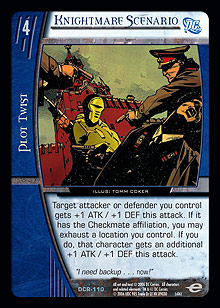 The next card to earn a slot was Knightmare Scenario. If there’s a single deck in Silver Age that would run Acrobatic Dodge if it could, it’s . . . well actually, it’s G’Lock. But Deep Green would be a close second. Knightmare Scenario may have a hefty threshold cost of 4, but it can have a dramatic effect on combat, especially on larger characters like Maxwell Lord. The additional cost of exhausting a location is easy to meet, usually with Brother I Satellite or (when we don’t control the initiative) Brother Eye. The next card to earn a slot was Knightmare Scenario. If there’s a single deck in Silver Age that would run Acrobatic Dodge if it could, it’s . . . well actually, it’s G’Lock. But Deep Green would be a close second. Knightmare Scenario may have a hefty threshold cost of 4, but it can have a dramatic effect on combat, especially on larger characters like Maxwell Lord. The additional cost of exhausting a location is easy to meet, usually with Brother I Satellite or (when we don’t control the initiative) Brother Eye.
Certain locations were obvious inclusions. We wanted four copies of Brother I Satellite as our primary character tutor. We wanted a decent number of team-ups to increase the likelihood of naturally drawing into one for the splashed late game characters. UN Building was the first choice, as it teams-up Talia, Beloved Betrayer and Ahmed for Checkmate, League of Assassins, and Villains United in a single team-up. Checkmate Safe House was a shoe-in, providing both a team-up and a defensive trick in one. Some other locations were obvious inclusions—The Science Spire, Brother Eye, Slaughter Swamp, Rook Control, Coast City, and Sewer System all offered powerful effects either for managing the board, managing our hand, or preventing our Kings from being taken. Pit of Madness provided another layer to the arsenal of defensive tricks against the inevitable aggressive decks. In early builds of the deck, we had two copies of Pit of Madness, which let us use one Pit and then KO it to Ahmed to fetch the second, giving +4 or even +8 DEF on a single attack. Leslie Thompkins’s Clinic (which generally acts like a weaker Lazarus Pit, although the endurance gain is more significant than it appears at first glance) was an enabler for Pit of Madness and provided a little extra insurance for our Kings in the event that Maxwell and Ahmed were both stunned and we weren’t teamed-up for The Science Spire.
All of this left us with some empty slots. At this point, we had enough of the deck together to run some test games against Squadron, which we considered the benchmark reality check for the deck. If it couldn’t hang with Squadron, we either needed to make changes or go back to the drawing board, as the Squad was likely to be well represented at the PC. We quickly found that although the plan for the first couple of turns worked well, we needed something extra to push us over the edge in the mid-game to overcome Rocket Central and naturally high ATK values. The result was one of the most surprisingly effective cards in the deck—Knight Armor. Suddenly, the Squadron matchup did a complete 180. Ahmed was coming down in the visible area. Merlyn was KO’ing Lady Lark, Linda Lewis on turn 4, and then Ahmed was attacking Golden Archer, Wyatt McDonald without stunning back. Although Albert Gaines ◊ Nuke, Atomic Powerhouse was still sometimes getting through Slaughter Swamp on turn 5, one attack could generally be brick-walled on that turn. Going into turn 6, Merlyn often had his cosmic counter intact and ready to KO Nuke. Four copies of Knight Armor went in, taking us up to around sixty cards for further, more serious testing.
This seems like a good time for a list. This list is from a point relatively late in the testing cycle. Most of the card slots had settled down, and the discussions that followed were over relatively minor issues of numbers and extra characters we might need.
Characters
4 Mikado and Mosha, Angels of Destruction
4 Talia, Beloved Betrayer
2 Sarge Steel, Knight
4 Ahmed Samsarra, White King
1 Graziella Reza, Knight
4 Merlyn, Deadly Archer
1 Fatality, Flawless Victory
1 Elimination Protocol ◊ OMAC Robot, Army
2 Maxwell Lord, Black King
1 Talia, Daughter of Madness
1 Annihilation Protocol ◊ OMAC Robot, Army
2 Huntress, Reluctant Queen
1 Sensei, Martial Arts Master
1 Asmodeus, Duke of Hell
1 Sasha Bordeaux, Autonomous Prototype
1 Spider-Man, The Amazing Spider-Man
Plot Twists
3 Enemy of My Enemy
4 Knightmare Scenario
Locations
4 Brother I Satellite
3 Checkmate Safe House
2 Brother Eye
2 Pit of Madness
1 UN Building
1 The Science Spire
1 Slaughter Swamp
1 Sewer System
1 Rook Control
1 Coast City
1 Leslie Thompkins’s Clinic
Equipment

When I left off, I’d gone through most of the process of testing that had produced the core of the deck. Lists flew around between members of the group, and we started to fiddle with numbers, test, and “debate” (not argue, debate) over email, all the while trying to work out what everyone else was likely to be playing at the PC and get as many face-to-face testing sessions in as possible. We also kept an eye on the major message boards to see if there was any sign of public awareness of the brutal effectiveness of Ahmed Samsarra, White King into Merlyn, Deadly Archer. There wasn’t; of course, this didn’t mean that the bigger teams like FTN or The Donkey Club didn’t have similar decks, just that it may have gone under the radar for everyone else. Dean in particular was still working on other decks—Justice League of Arkham, a Fate Artifact deck that was obviously shelved with the change to the uniqueness rules for equipment, and a couple of other brain-achingly complicated Sohnle specials.
We still hadn’t found anything that gave Deep Green serious trouble. The worst matchup we could find was a quirky Shadowpact / X-Statix stall deck built to win with Captain Marvel, Champion of Magic on turn 6 or 7. The downside for that deck was its almost total inability to deal with discard and its pretty horrendous matchup with G’Lock, a deck we were expecting (erroneously) to show in quite high numbers. Critically, it was also less consistent than the Checkmate deck.
By the time the weekend before the PC rolled around (with a public holiday on Monday for good measure), the deck was pretty much set. A few cards kept coming in and out—Metallo, John Corben; Latverian Embassy; a package involving removing two Mikado and Moshas and another card for two copies of Wild Ride and a Marvel Knights 2-drop. But the core of the deck was set and would remain so until Ian and the Canadians met up in San Francisco. Testing for Draft, at this point, was occupying more and more of our testing time.
So, the list that Ian ended up playing to such a spectacular finish?
Characters
4 Mikado and Mosha, Angels of Destruction
4 Talia, Beloved Betrayer
1 Sarge Steel, Knight
4 Ahmed Samsarra, White King
1 Graziella Reza, Knight
1 Sage, Xavier’s Secret Weapon
3 Merlyn, Deadly Archer
1 Elimination Protocol ◊ OMAC Robot, Army
1 Fatality, Flawless Victory
1 Deathstroke the Terminator, Lethal Weapon
1 Metallo, John Corben
1 Maxwell Lord, Black King
1 Talia, Daughter of Madness
2 Annihilation Protocol ◊ OMAC Robot, Army
2 Huntress, Reluctant Queen
1 Sensei, Martial Arts Master
1 Asmodeus, Duke of Hell
1 Sasha Bordeaux, Autonomous Prototype
1 Spider-Man, The Amazing Spider-Man
Plot Twists
3 Enemy of My Enemy
3 Knightmare Scenario
Locations
4 Brother I Satellite
3 Brother Eye
3 Checkmate Safe House
1 Coast City
1 Leslie Thompkins’s Clinic
1 Pit of Madness
1 Rook Control
1 Sewer System
1 Slaughter Swamp
1 The Science Spire
1 UN Building
Equipment
4 Knight Armor
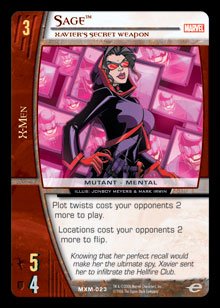 Some changes were made after the team arrived in San Francisco, obviously. The numbers of Maxwell Lord, Black King and Annihilation Protocol ◊ OMAC Robot, Army reversed to provide more hand-size fuel for Brother Eye when off initiative. Sage, Xavier’s Secret Weapon came in to help against Ivy League, and Deathstroke the Terminator, Lethal Weapon came in as a defensive Villains United 4-drop in case we felt the need to get The Science Spire online in a hurry. The third Brother Eye came in because you always want to draw one, and using multiples in a single turn can end the game faster than your opponent expects. Some changes were made after the team arrived in San Francisco, obviously. The numbers of Maxwell Lord, Black King and Annihilation Protocol ◊ OMAC Robot, Army reversed to provide more hand-size fuel for Brother Eye when off initiative. Sage, Xavier’s Secret Weapon came in to help against Ivy League, and Deathstroke the Terminator, Lethal Weapon came in as a defensive Villains United 4-drop in case we felt the need to get The Science Spire online in a hurry. The third Brother Eye came in because you always want to draw one, and using multiples in a single turn can end the game faster than your opponent expects.
After San Francisco and After Ivy League
Now, this was where I was going to give a list for the tweaks and changes that a post-PC revision might involve, but then UDE announced an absolutely necessary banning of Justice League of Arkham. Without the 800-pound gorilla in the room, the deck can streamline back toward the original builds. The effect on the metagame will obviously be noticed; G’Lock just lost its 0-20 matchup and may suddenly vault back into popularity, which means that Asmodeus probably needs to stay in. The locations don’t change a huge amount. Latverian Embassy becomes a lot weaker without Ivy League or Faces of Evil variants to beat on, and The Alley becomes stronger with the popularity of Fatality, Flawless Victory.
So without further ado, here’s the post-banning build that I’d take to a Silver Age tournament, taking into account both the surviving decks from the PC and some of the developments from $10K Hamilton (mainly the consolidation of Fate Squadron as a heavily played deck in its own right).
Characters
4 Mikado and Mosha, Angels of Destruction
4 Talia, Beloved Betrayer
1 Sarge Steel, Knight
4 Ahmed Samsarra, White King
1 Graziella Reza, Knight
4 Merlyn, Deadly Archer
1 Elimination Protocol ◊ OMAC Robot, Army
1 Fatality, Flawless Victory
1 Metallo, John Corben
2 Annihilation Protocol ◊ OMAC Robot, Army
1 Maxwell Lord, Black King
1 Talia, Daughter of Madness
2 Huntress, Reluctant Queen
1 Sensei, Martial Arts Master
1 Asmodeus, Duke of Hell
1 Sasha Bordeaux, Autonomous Prototype
1 Spider-Man, The Amazing Spider-Man
Plot Twists
3 Enemy of My Enemy
4 Knightmare Scenario
Locations
4 Brother I Satellite
3 Checkmate Safe House
3 Brother Eye
1 Coast City
1 Leslie Thompkins’s Clinic
1 Pit of Madness
1 Rook Control
1 Sewer System
1 Slaughter Swamp
1 The Science Spire
1 UN Building
Equipment
4 Knight Armor
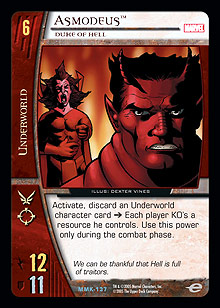 Remember as you play and test that Deep Green was originally conceived to be, and generally plays as, a control deck. Note that this controlling tendency doesn’t always manifest itself as dragging the game out to later and later turns; it’s more about controlling the pace of the game. Deep Green isn’t a stall deck with an inevitable win condition once we reach a certain turn, but it is capable of controlling the tempo of the game and then choosing the best time to start going in for the kill. In some matchups (G’Lock, for example), you’ll want to spend the early turns consolidating your board and setting up your resource row, only attacking when it costs you nothing to do so because you know that Asmodeus, Duke of Hell will allow you to lock the game up later on. Against aggro decks like Squadron, the plan is to spend the early turns preventing damage and keeping a handle on the board. Your ideal turn 2 involves 2-drops trading and Mikado and Mosha stunning the opposing 1-drop. The complicating factor for Silver Age as it develops is Fate Squadron, and I would recommend that anyone who plans to run this deck test thoroughly against Fate Squadron before taking it to a tournament. Although the deck was built to be strong against regular Squadron, picking up any deck cold and expecting the deck to win for you is foolish. Play the matchup a few times with good testing partners, talk to them about why they thought they were having trouble against you, then think about whether what you were doing was playing into the weaknesses your opponent was worrying about. Remember as you play and test that Deep Green was originally conceived to be, and generally plays as, a control deck. Note that this controlling tendency doesn’t always manifest itself as dragging the game out to later and later turns; it’s more about controlling the pace of the game. Deep Green isn’t a stall deck with an inevitable win condition once we reach a certain turn, but it is capable of controlling the tempo of the game and then choosing the best time to start going in for the kill. In some matchups (G’Lock, for example), you’ll want to spend the early turns consolidating your board and setting up your resource row, only attacking when it costs you nothing to do so because you know that Asmodeus, Duke of Hell will allow you to lock the game up later on. Against aggro decks like Squadron, the plan is to spend the early turns preventing damage and keeping a handle on the board. Your ideal turn 2 involves 2-drops trading and Mikado and Mosha stunning the opposing 1-drop. The complicating factor for Silver Age as it develops is Fate Squadron, and I would recommend that anyone who plans to run this deck test thoroughly against Fate Squadron before taking it to a tournament. Although the deck was built to be strong against regular Squadron, picking up any deck cold and expecting the deck to win for you is foolish. Play the matchup a few times with good testing partners, talk to them about why they thought they were having trouble against you, then think about whether what you were doing was playing into the weaknesses your opponent was worrying about.
A few specific cards that could be added to the deck bear mentioning. The first is Phantom Zone. The current build only sports a single Revenge Squad character (Metallo, John Corben), and obviously it won’t always be worth dropping such a specifically focused character just to get Phantom Zone online. An intriguing alternative can be found in the deck played by Craig Edwards at Pro Circuit San Francisco, which included two copies of Superman, Clark Kent. While Superman may at first seem unexciting, he has a particularly strong interaction with Sarge Steel, Knight that makes him a definite contender if you feel the need to add Phantom Zone to deal with KO pile–dependent decks that are popular locally.
The Alley is another potentially useful location. It’s particularly effective at blunting an opposing Fatality, Flawless Victory. We didn’t find room for it in the end, but with the increasing popularity of the Villains United 4-drop, there is a very strong argument for including it, possibly over Leslie Thompkins’s Clinic.
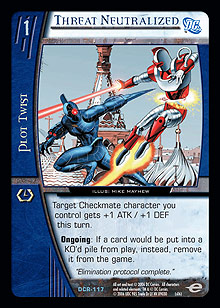 Threat Neutralized has found itself in a strange position. Currently, it is both better than it was at the Pro Circuit and better than it will be after July 1. The reason for this is that after the Pro Circuit, there was a change in the rules that effectively plugged a loophole that decks like Ivy League were using to get around Threat Neutralized. Basically, if you KO a character to pay a cost (whether of a plot twist or payment power), that KO could not be replaced by Threat Neutralized with removal from the game. This meant that even with Threat Neutralized face up, Ivy League could still KO characters to Poison Ivy, Deadly Rose and could still KO Hope, Amazon Bodyguard to use her payment power. It also meant that the characters would hit the KO’d pile to be retrieved with Slaughter Swamp Threat Neutralized has found itself in a strange position. Currently, it is both better than it was at the Pro Circuit and better than it will be after July 1. The reason for this is that after the Pro Circuit, there was a change in the rules that effectively plugged a loophole that decks like Ivy League were using to get around Threat Neutralized. Basically, if you KO a character to pay a cost (whether of a plot twist or payment power), that KO could not be replaced by Threat Neutralized with removal from the game. This meant that even with Threat Neutralized face up, Ivy League could still KO characters to Poison Ivy, Deadly Rose and could still KO Hope, Amazon Bodyguard to use her payment power. It also meant that the characters would hit the KO’d pile to be retrieved with Slaughter Swamp; Dr. Light, Master of Holograms; or Hard Sound Construct. Now, that loophole has been closed, which means that for the few remaining weeks of Silver Age with Ivy League legal, Threat Neutralized is a much more effective card and should be considered a more likely inclusion than it was during Pro Circuit preparation.
Deathstroke the Terminator, Ultimate Assassin has been sighted in lists for a number of Checkmate builds, and I should point out that I don’t consider him to be that appropriate for this particular deck. Deep Green is, at its heart, a control deck. As such, I more highly value Spider-Man’s ability to steal the initiative and manage potential problem characters like Merlyn; Gorilla Grodd, Simian Mastermind; and a Deathstroke the Terminator on the other side of the board. Certainly he seems like a natural fit for the more aggressive Checkmate / Villains United decks like the one played by Tim Batow in the Top 8 of Pro Circuit San Francisco.
One last two-card package that at least deserves a mention is Dr. Fate’s Tower with Cloak of Nabu. In all honesty, I can only recommend this if you’re likely to be seeing a lot of mirror matches, as there aren’t all that many non-plot-twist targeted powers to worry about. Merlyn is the big one, and some late game cards like Deathstroke the Terminator, Ultimate Assassin; Spider-Man, The Amazing Spider-Man; and Gorilla Grodd are also worth mentioning. Although immunity from such effects is nice, I’m not convinced that the Cloak of Nabu package will help that much, and there is certainly a risk of compromising other matchups. Also, even in a matchup where Cloak of Nabu is useful, it might not be necessary. Is G’Lock suddenly going to be able to beat Asmodeus by stealing your Merlyn after he’s already KO’d Dr. Light and a 4-drop, for example? In the Checkmate mirror, an opposing Deathstroke the Terminator, Ultimate Assassin will only become stunned when you decide he becomes stunned, thanks to Spider-Man, The Amazing Spider-Man. And if you have dueling Spider-Men . . . Well, I hope you have plenty of caffeine. It’s possible that the Cloak of Nabu package is worth running before July 1, when it gives you some ability to protect Sage from Deadshot, Floyd Lawton.
This is the point where you’d expect some “carefully worked out” (or “something that sounds about right”) percentages against the various other decks in the field, but I’m afraid you’re not going to get one. I’m not a big fan of talking about matchups in terms of percentages, as they assume too much and are too susceptible to being thrown off by even small changes in build. That said, even in the currently mysterious post-banning environment, there are a few obvious decks to pick out as contenders.
Squadron / Fate Squadron / Mexican Hardware Store
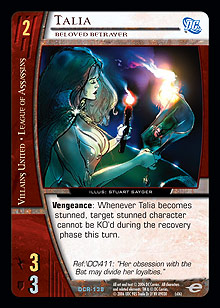 One of the first things we did with even the first draft of the deck was make sure that it was strong against existing builds of Squadron Supreme. Ian and I agreed that if we couldn’t get the deck to a comfortable matchup with Squad, we likely needed a serious rethink or a new deck (remember that this was only the day after the Sneak Peek tournament and the first deck either of us had built with cards from Infinite Crisis, so we were prepared to be testing and ditching new builds while looking for “the one”). Happily, the deck performed well. There are a few points in the game where particular “set-piece” plays can be nice; taking down a 2-drop on turn 2 with Talia, Beloved Betrayer, then pitching Mikado and Mosha to stun Joystick, Janice Yanizesh is a feeling I’ll never get tired of. Attacking up into Golden Archer, Wyatt McDonald with Ahmed on turn 4 without fearing a stunback, even with Rocket Central face up and active, is another. (Knight Armor’s +4 DEF on the attack makes this possible.) Merlyn’s ability to remove chunks of the board without risking stun endurance loss or damage to your own position is obviously nice, and the raw number of +2 DEF effects conspire to make brick-walling an attack on turn 5 or 6 perfectly possible, at which point Merlyn can simply take over the game from the safety of the hidden area. One of the first things we did with even the first draft of the deck was make sure that it was strong against existing builds of Squadron Supreme. Ian and I agreed that if we couldn’t get the deck to a comfortable matchup with Squad, we likely needed a serious rethink or a new deck (remember that this was only the day after the Sneak Peek tournament and the first deck either of us had built with cards from Infinite Crisis, so we were prepared to be testing and ditching new builds while looking for “the one”). Happily, the deck performed well. There are a few points in the game where particular “set-piece” plays can be nice; taking down a 2-drop on turn 2 with Talia, Beloved Betrayer, then pitching Mikado and Mosha to stun Joystick, Janice Yanizesh is a feeling I’ll never get tired of. Attacking up into Golden Archer, Wyatt McDonald with Ahmed on turn 4 without fearing a stunback, even with Rocket Central face up and active, is another. (Knight Armor’s +4 DEF on the attack makes this possible.) Merlyn’s ability to remove chunks of the board without risking stun endurance loss or damage to your own position is obviously nice, and the raw number of +2 DEF effects conspire to make brick-walling an attack on turn 5 or 6 perfectly possible, at which point Merlyn can simply take over the game from the safety of the hidden area.
Fate Squadron is trickier, as Merlyn loses some of his power. That said, in running eleven Fate Artifacts and three copies of Dr. Fate’s Tower, the deck necessarily runs light on other combat tricks. Your combat math becomes a simple question of your opponent’s on-board stats and the possibility of maybe a single power-up or, at worst, an Other-Earth (unless your opponent has already played a plot twist, of course), which means that you can save your pumps for the fights you know you can win. Fate Squadron decks also make themselves a lot more vulnerable to a mid-combat Slaughter Swamp shrinking Albert Gaines ◊ Nuke, Atomic Powerhouse or an activation in response to Answer the Call or Panacea Potion. If it will remove a full set, you should also not be averse to attacking an Artifact-laden character for the stun, then using Merlyn to KO it while the Cloak of Nabu is inactive (just watch out for Panacea Potion). Later in the game, don’t forget the option of fetching Metallo while on initiative to deal with a particularly troublesome Fate monster; Sewer System will let him snipe out Fate characters, regardless of who they try to hide behind.
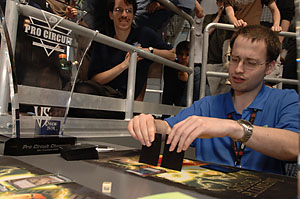 Mexican Hardware Store is certainly one of the best aggressive decks in the format. It should be pointed out right away that Mexican Hardware Store is not a Squadron deck. It’s closer to High Voltage in that it runs a whole array of aggressive characters from a wide range of teams and backs them up with burn and equipment. Here I will point you to the feature match coverage of the finals of the Pro Circuit and to Ian’s report of the event when it’s available. Really, although Mexican Hardware Store isn’t a Squadron deck, it is comparable for our purposes. It’s a short-curve rush deck packed with efficient characters, enough search cards to ensure consistency, and the most appropriate combat tricks; although unlike Silver Age Squadron, it runs a greater number of burn cards. One thing you will pick up from the finals coverage is that this matchup is one in which you’re comfortable with the (normally second choice) odd initiatives. This allows you to make Ahmed in the hidden area on turn 3 and attack with him, then play Merlyn on turn 4 and hide him with Rook Control. If possible, equipping Ahmed with Knight Armor after making him visible will also help. This matchup will not ever be one that feels comfortable while you’re actually playing, but no matter how hairy it feels taking the beats over the first few turns, you should come out on top more often than not. Mexican Hardware Store is certainly one of the best aggressive decks in the format. It should be pointed out right away that Mexican Hardware Store is not a Squadron deck. It’s closer to High Voltage in that it runs a whole array of aggressive characters from a wide range of teams and backs them up with burn and equipment. Here I will point you to the feature match coverage of the finals of the Pro Circuit and to Ian’s report of the event when it’s available. Really, although Mexican Hardware Store isn’t a Squadron deck, it is comparable for our purposes. It’s a short-curve rush deck packed with efficient characters, enough search cards to ensure consistency, and the most appropriate combat tricks; although unlike Silver Age Squadron, it runs a greater number of burn cards. One thing you will pick up from the finals coverage is that this matchup is one in which you’re comfortable with the (normally second choice) odd initiatives. This allows you to make Ahmed in the hidden area on turn 3 and attack with him, then play Merlyn on turn 4 and hide him with Rook Control. If possible, equipping Ahmed with Knight Armor after making him visible will also help. This matchup will not ever be one that feels comfortable while you’re actually playing, but no matter how hairy it feels taking the beats over the first few turns, you should come out on top more often than not.
G’Lock
G’Lock will probably become more popular again now that Ivy League has been taken out of the picture, and this can only be a good thing for Deep Green. Unless G’Lock undergoes very substantial changes, they have serious issues dealing with a deck that aims to control the board outside combat in the way that Deep Green can with Merlyn and Asmodeus. Against a deck with 4 ATK / 10 DEF 4-drops and 6 ATK / 11 DEF 5-drops, Merlyn is a beast, particularly while in the hidden area. And Asmodeus prevents G’Lock from ever reaching the turns at which it expects to dominate. While G’Lock may be fine against the newer aggro decks, and possibly also against the non-League builds of Checkmate, it will need some quite serious changes to have much of a hope against Deep Green.
TAWC Checkmate / Villains United
Win the coin flip and take evens. No, really. When you’re up against the TAWC build of Checkmate, initiative becomes king (if you’ll pardon the pun). With evens, you activate Merlyn on turn 4, which means you’re not losing a character to combat stuns. They get to attack with their 4-drop and 5-drop on turn 5, which will often result in you losing a single character. Then on turn 6, you KO another character with Merlyn and attack (hopefully with Knight Armor), and on turn 7, you steal the initiative with Spider-Man. Things look noticeably worse with odds, and there isn’t really a lot you can do about it; the best advice I can give to you is to make sure you have a suitably lucky coin and to devote some time to putting together a reliable plan for the games when you’re stuck with odds. That’s what we tried to do with Christopher Smith and Fatality, but it just never really worked out.
All in all, Silver Age is shaping up to be one of the most interesting Constructed formats the game has seen. Even with the objectively broken Ivy League running around, the massive complexity of the deck has prevented it from dominating in terms of numbers. Post Ivy League, representatives of all the major archetypes look viable—G’Lock and X-Mental for stall; Mexican Hardware Store, Good Guys, and Fate Squad for short-curve rush; TAWC and Deep Green for full-curve control; and the JLI / Masters of Evil deck based around The Wrecking Crew deck for swarm. And all that from just two events! All in all, the Silver Age format is looking like a resounding success, and I look forward to seeing even more interesting developments from the upcoming PCQs.
|
| |
| Top of Page |
|
 |
|
|
 |